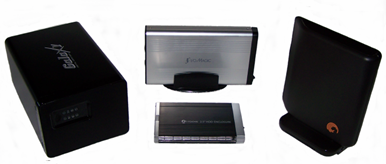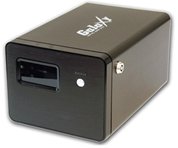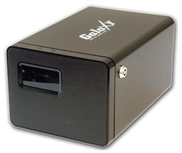Do It Yourself External Hard Drive Backup Solutions
 In this, the third part of the home data backup series, we’ll discuss the various options one has in creating a backup solution using external Hard Drives. We’ll look at what’s available on the market and how best to use them. Ideally, a backup solution should be easy to create and even easier to use. Once we’ve looked over a little of what’s available, we’ll build a large capacity backup solution that will handle just about anyone’s requirements for secure data storage, will be easy to use, and will give more bang for the buck than most commercially available solutions. Let’s talk briefly about some of the devices available on the market.
In this, the third part of the home data backup series, we’ll discuss the various options one has in creating a backup solution using external Hard Drives. We’ll look at what’s available on the market and how best to use them. Ideally, a backup solution should be easy to create and even easier to use. Once we’ve looked over a little of what’s available, we’ll build a large capacity backup solution that will handle just about anyone’s requirements for secure data storage, will be easy to use, and will give more bang for the buck than most commercially available solutions. Let’s talk briefly about some of the devices available on the market.
Simple USB Enclosures: There are a wide variety of enclosures available that will utilize either a 2.5 inch or 3.5 inch hard drive to create an external drive of the size you choose. You’ll find everything from a “Plain Jane” box to cases that have bells, whistles, flashing lights, and sirens. Well…maybe not sirens, but there are some pretty flashy units available out there and you can build a viable backup solution that fits your tastes by simply adding an internal HDD to the enclosure of your choice. Prices range from less than $20.00 to over $150.00 (not including the HDD’s or backup software).
External Hard Drives: If you don’t want to build your own device, there are also external hard drives available that need only be connected to the machine and you’re off and running. Just about every manufacturer that offers hard drives also offers these devices and with the “plug and play” ease of use, they are a good choice for anyone needing external storage solutions. Prices range from about $50.00 (60GB) to about $2000.00 (6TB). They do not include backup software.
External Backup Solutions: Again, there are a wide variety of external backup solutions available from a variety of manufacturers. Some are reasonably priced…some can be pretty spendy. If you need a lot of space (a Terabyte or more), be prepared for a little sticker shock. You’ll find most of the offerings start at a little over $250.00 (1TB) and range to well over $1000.00. These devices will usually include the software needed to backup your computer.
Software: There are quite a number of applications available that will back up your data, your system, or both. Acronis True Image, Norton Ghost, Genie Backup Manager, Roxio BackOnTrack, and NovaBackup all come to mind and are all very adequate backup applications. These range in cost from $50.00 to $70.00.
Let’s build a backup solution!
For this project, I want to build a 1TB (~1,000 GB) device that’s expandable with an automated backup capability that is affordable and versatile. I chose Galaxy enclosures for this as they offer hot swappable drive bays, and offer more versatility when configuring the drives. This is a very convenient feature in most respects, but will likely not be used much by the normal computer user. The drives can be configured to be used as a single large drive, or you can use the drives separately
First, I used Galaxy Metal Gear’s 3508UC One Button Backup enclosure which includes PCCloneEX Software. These are metal enclosures that have locking access doors for security, have active cooling, and connect up via either USB or FireWire. Pressing the button on the front of the enclosure starts the backup.
 This enclosure offers several attractive options including hot swappable drive bays (2) as already mentioned. Hot swapping allows one to remove and replace drives without powering down the enclosure or having to use the “Safely Remove” feature in Windows. The enclosure also has the ability to utilize all the drives installed in it as a single large drive, or the drives can be configured to show as separate drives, and you can use drives of different sizes together. Each configuration can be handy depending on the circumstances.
This enclosure offers several attractive options including hot swappable drive bays (2) as already mentioned. Hot swapping allows one to remove and replace drives without powering down the enclosure or having to use the “Safely Remove” feature in Windows. The enclosure also has the ability to utilize all the drives installed in it as a single large drive, or the drives can be configured to show as separate drives, and you can use drives of different sizes together. Each configuration can be handy depending on the circumstances.
I installed two 1TB SATA HDD’s, first as a single large drive. I immediately found a problem with this (stated in the documentation supplied with the unit). This configuration uses JBOD (Just a Bunch Of Disks) which combines the installed drives into a single logical drive. This is known as Spanning or Concatenating the drives and it has it’s draw-backs. Removing one drive, whether purposely or through a hardware failure, will effectively destroy the data on both drives. Not what you want in a backup solution. When configured as separate drives, however, I was presented with a very viable backup solution and the drives can be removed and installed at will.
Then came problem two…the software supplied with the unit is barely adequate. Pressing the button to start the backup in reality only starts the PCCloneEX application. Then you’ll have to tell it what you want to back up. It will back up the data (files and settings), but will not back up the system state, and it will only run under Windows. If you have your system go down through hardware failure or operating system corruption, you will have to get the machine running and install the PCClone software in order to recover your data. That’s ok, I suppose, but it’s not the solution I wanted. I wanted a full recovery option. So, keep the enclosure, toss the software, and forget the “One Button Backup”.
I chose to use Acronis True Image software in place of the supplied PCCloneEX, but there are others available for around the same price. Now I had the option for scheduled backups to the location of my choice with the ability to make a full drive image and add incremental backups to that as the system and data changed. I now have the backup solution I was after at a very reasonable price for the size, convenience, and capabilities of the device. I can literally restore the machine to it’s current configuration in minutes instead of hours. I can back up all of my computers to this single drive and still have room for nearly unlimited incremental backups. Total cost of this 2TB backup solution was $489.96…including the Acronis software, which is about in line with retail offerings, but is far more versatile.
Some of us require a little more piece of mind, so I decided to try a redundant array. For this I used the Galaxy Metal Gear 3538UEP enclosure which provides several RAID configurations, but comes with no backup software. No biggie. I wasn’t impressed with the software anyway. It still offers two hot swappable  bays, but also gives you the ability to build in some redundancy by using RAID 1, commonly called a mirrored drive array. When data is written to a RAID 1 array, it is written to all disks simultaneously and the data will remain accessible so long as one disk in the array continues to function. This process will see both drives, but only report them as a single drive, or half of what is actually installed. To use the RAID configurations, both installed drives must be of the same type and capacity so, when compared to the first enclosure, it seems you are a little more limited with how you can configure the drives. However, when you backup using this configuration, it is written to both drives simultaneously, effectively creating two separate and viable backups at the same time. Should one drive fail or the data become corrupt, you still have a viable backup available. A nice option, indeed.
bays, but also gives you the ability to build in some redundancy by using RAID 1, commonly called a mirrored drive array. When data is written to a RAID 1 array, it is written to all disks simultaneously and the data will remain accessible so long as one disk in the array continues to function. This process will see both drives, but only report them as a single drive, or half of what is actually installed. To use the RAID configurations, both installed drives must be of the same type and capacity so, when compared to the first enclosure, it seems you are a little more limited with how you can configure the drives. However, when you backup using this configuration, it is written to both drives simultaneously, effectively creating two separate and viable backups at the same time. Should one drive fail or the data become corrupt, you still have a viable backup available. A nice option, indeed.
Again, I used the Acronis True Image Software to automate the backups and was able to backup multiple machines to the single array, with room to spare. Total cost of this solution was $529.96 (including software) which is still comparable to commercially available backup solutions. While these prices seem quite high, they can be easily scaled by changing the size of the HDD’s you use. If you only want 1 TB of storage, you can install one 1TB HDD or two 500GB drives, which will bring the price down significantly.
If you are running on Vista (Ultimate or above), you won’t need the software as Vista has it’s own backup feature, though it only saves your data, not the system state. This can represent an additional savings of $49.99 providing you are interested only in securing the data. Under these circumstances it would be possible to build an impressive automated 1TB backup solution for about $230.00 ($280.00 if you include the Acronis software). Or, about the cost of a plain Jane external HDD of similar capacity.
Some folks will not need such large capacities, redundancy, or security. A good solution for these users would be good backup software, and a commercially available external drive that fits their budget. Good backup solutions can be acquired that fit just about any budget and there are many different software choices when it comes to backups.
As for me, I settled on the 1TB mirrored array and am secure in the knowledge that I can restore any of my systems and the data they contain in minutes from either of two viable system images. As for the enclosure, I chose not to use for the backup solution. I’ll be using that as a large capacity storage drive, and will be able to use it for any purpose that requires installation of a drive to one of my machines — such as data recovery or formatting.
Let’s recap!
The Software: The solutions I chose, while adequate under most circumstances, do not provide a complete backup solution right out of the box. The software provided (PCCloneEX) is slow and will back up data only. I was not impressed. However, using the third party software (Acronis True Image) allowed for a complete system backup and gave me the option to schedule either complete or incremental backups at a time of my choosing and without input from me. Additionally, the backup software can be used with any external storage device of adequate size to provide a backup solution.
The Hardware: The Galaxy Metal Gear enclosures perform admirably, are easily configurable, and provide the potential for a massive amount of storage. The actual assembly required amounted to sliding the HDD’s into a bay, closing the bay door, and flipping a switch. Setting up took literally minutes to accomplish. The hardware I used allowed a great deal of scalability (both in capacity and price), several storage configurations, and is readily available through many retail outlets, as well as from several online shopping sites. The hard drives I used as backup media (WD 1TB SATA) can be easily removed and stored in an offsite facility or fire proof safe for security. Restoring the system takes a fraction of the time it would take to install a new system, and all the support software required to put things back as they were.
I didn’t end up with a one button backup solution as I had hoped. Instead I have a fully automated backup solution that is simple to use, has a significant storage capacity, and is very reliable. Having good backups of your data is not just important, it’s critical.
Happy computing!

